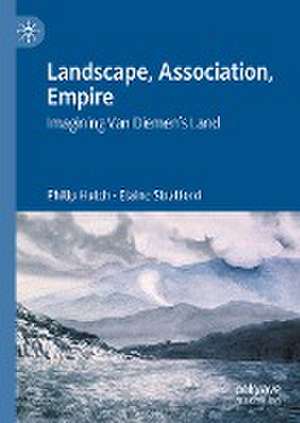Landscape, Association, Empire: Imagining Van Diemen’s Land
Autor Philip Hutch, Elaine Stratforden Limba Engleză Hardback – 3 dec 2023
Preț: 799.97 lei
Preț vechi: 879.09 lei
-9% Nou
Puncte Express: 1200
Preț estimativ în valută:
153.07€ • 166.80$ • 128.99£
153.07€ • 166.80$ • 128.99£
Carte tipărită la comandă
Livrare economică 19-25 aprilie
Preluare comenzi: 021 569.72.76
Specificații
ISBN-13: 9789819954186
ISBN-10: 9819954185
Pagini: 217
Ilustrații: XXV, 217 p. 62 illus., 59 illus. in color.
Dimensiuni: 148 x 210 mm
Greutate: 0.44 kg
Ediția:1st ed. 2023
Editura: Springer Nature Singapore
Colecția Palgrave Macmillan
Locul publicării:Singapore, Singapore
ISBN-10: 9819954185
Pagini: 217
Ilustrații: XXV, 217 p. 62 illus., 59 illus. in color.
Dimensiuni: 148 x 210 mm
Greutate: 0.44 kg
Ediția:1st ed. 2023
Editura: Springer Nature Singapore
Colecția Palgrave Macmillan
Locul publicării:Singapore, Singapore
Cuprins
1. Introduction.- 2. Frames, Canvases, and Perspectives.- 3. Mapping and Picturing Worlds: Harris, Evans, Frankland.- 4. Relocation and Return: Lycett and Prout.- 5. Making Home Place: Allport and Meredith.- 6. Reflections and Horizons.
Notă biografică
Philip Hutch is an honorary associate in the School of Geography, Planning, and Spatial Sciences at the University of Tasmania. His research focus is on the intellectual history of pictures of place and landscape and on association and processes of mind.
Elaine Stratford is a professor in the School of Geography, Planning, and Spatial Sciences at the University of Tasmania, with interests in the geohumanities and cultural and political geography and in how people flourish in place, in their movements, in daily life, and over the life-course.
Elaine Stratford is a professor in the School of Geography, Planning, and Spatial Sciences at the University of Tasmania, with interests in the geohumanities and cultural and political geography and in how people flourish in place, in their movements, in daily life, and over the life-course.
Textul de pe ultima copertă
Long-standing imaginings of Van Diemen’s Land—as island, as ends of worlds, as pristine wilderness, as emptied of Aborigines—continue to shape contemporary lutruwita/Tasmania. In this superbly contextualised engagement with the work of seven colonial artists, Hutch and Stratford show how associationist thinking was integral to settler landscapes of dispossession and possession. Landscape, Association, Empire provides a surprisingly hopeful wrestling with the fraught legacies of settler colonialism; the future can be imagined otherwise. —Professor Lesley Head, University of Melbourne, Australia
Landscape, Association, Empire explores how representation echoes, shapes, and haunts understanding. It carefully documents the interplay of art, image, policy, and action that tried to create Van Diemen’s Land as a place of white innocence and Indigenous absence in the presence of genocide. Its impressive scholarship traces the contexts of colonising through place-making and place-imagining as distilled in landscape paintings. It insists that representation is never neutral or context free; always it has consequences. Hutch and Stratford’s brilliant rethinking of colonial imagery undermines narratives of settlement, inviting new conceptualisations of how Tasmania’s pasts, presents, and futures connect. —Professor Richie Howitt, Macquarie University, Australia
This fascinating and important book critically examines the diverse works of seven nineteenth century topographical artists, surveyors and writers in Van Diemen’s Land. It is illustrated with over 60 carefully selected drawings, paintings, and maps. The authors provide many original and thought-provoking insights into the ways settlers’ aesthetic associations were used to construct different ideas of place and home.
—Professor Charles Watkins, University of Nottingham, UK
Philip Hutch is an honorary associate in the School of Geography, Planning, and Spatial Sciences at the University of Tasmania. His research focus is on the intellectual history of pictures of place and landscape and on association and processes of mind.Elaine Stratford is a professor in the School of Geography, Planning, and Spatial Sciences at the University of Tasmania, with interests in the geohumanities and cultural and political geography and in how people flourish in place, in their movements, in daily life, and over the life-course.
Landscape, Association, Empire explores how representation echoes, shapes, and haunts understanding. It carefully documents the interplay of art, image, policy, and action that tried to create Van Diemen’s Land as a place of white innocence and Indigenous absence in the presence of genocide. Its impressive scholarship traces the contexts of colonising through place-making and place-imagining as distilled in landscape paintings. It insists that representation is never neutral or context free; always it has consequences. Hutch and Stratford’s brilliant rethinking of colonial imagery undermines narratives of settlement, inviting new conceptualisations of how Tasmania’s pasts, presents, and futures connect. —Professor Richie Howitt, Macquarie University, Australia
This fascinating and important book critically examines the diverse works of seven nineteenth century topographical artists, surveyors and writers in Van Diemen’s Land. It is illustrated with over 60 carefully selected drawings, paintings, and maps. The authors provide many original and thought-provoking insights into the ways settlers’ aesthetic associations were used to construct different ideas of place and home.
—Professor Charles Watkins, University of Nottingham, UK
Philip Hutch is an honorary associate in the School of Geography, Planning, and Spatial Sciences at the University of Tasmania. His research focus is on the intellectual history of pictures of place and landscape and on association and processes of mind.Elaine Stratford is a professor in the School of Geography, Planning, and Spatial Sciences at the University of Tasmania, with interests in the geohumanities and cultural and political geography and in how people flourish in place, in their movements, in daily life, and over the life-course.
Caracteristici
Explores the work of seven artists and their imperial, colonial, visual, and geographical legacies Shares a captivating story about empire and colony, centre and island periphery, and place and migration Richly illustrated and written in plain English, this book is accessible to diverse readers across several disciplines
